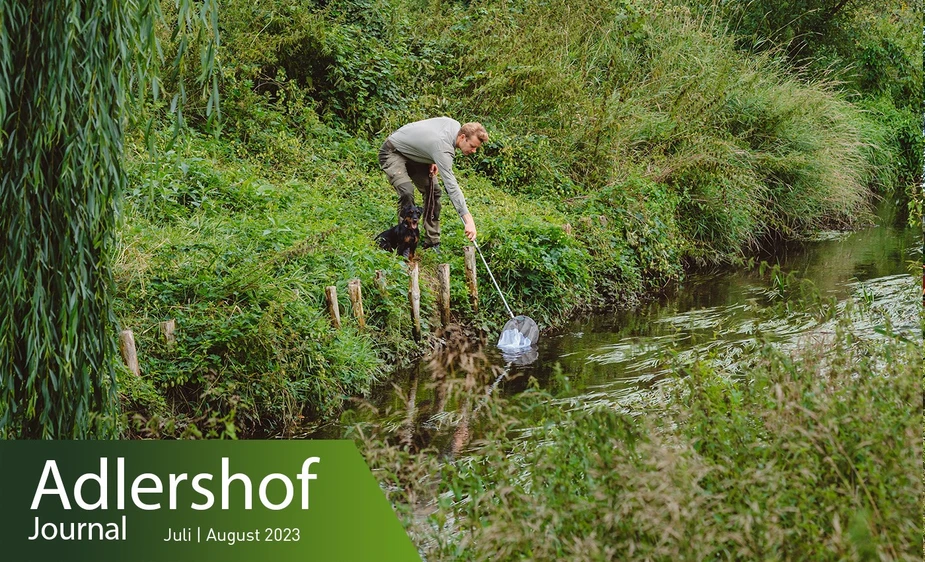On safari at home
The City Nature Rangers know all about what’s crawling and buzzing in Adlershof
Rangers are known as the guardians of certain landscape areas, mostly large national parks, but not of cities. However, the latter is populated by more than a few animals as well. In 2019, the Senate Department for Mobility, Transport, Climate Protection and the Environment commissioned the founding of the project “City Nature Rangers” in coordination with Stiftung Naturschutz Berlin, an environmental foundation. It’s the only one of its kind in Germany. The rangers mediate between the human inhabitants of the German capital and its animal populations in educational talks and guided tours.
Nancy Manke works in the Treptow-Köpenick district. As a City Nature Ranger, she is responsible, among other things, for landscape management at the landscaped park in Johannisthal together with her colleague Julius Kiso, and she records and identifies plants. Her professional focus is on butterflies, toads, and lizards. “The deadwood piles, stone structures and biotopes on the former airfield are an optimal habitat for reptiles and insects. We have about 160 butterfly species, 100 species of ground beetles, and 19 species of grasshoppers. The most prominent of them is probably the blue-winged grasshopper.” Unsurprisingly, the insect is easily identified by its blue wings. “Moreover, we have over 350 wild bee and wasp species,” says Manke. This makes the former airfield one of the most species-rich areas in Berlin.
The 65-hectare area is also an exciting place for bird watchers. “If you listen carefully, you will hear many skylarks.” The bird is fairly easy to identify and good for beginners. “The males take off 50 metres into the sky and then hover in one spot.” Wheatears, an endangered sparrow species with only a few thousand breeding pairs left in Germany, can also be watched breeding in rock piles. Sheep live in the park as natural lawnmowers and deer can be seen jumping across the heath.
Larger animals can also be found in Berlin, particularly the “big five”: pine marten, fox, rabbit, wild boar, and raccoon. “Foxes roam Adlershof and I have encountered wild boar in broad daylight on several occasions,” Manke tells us. However, caution is advised when encountering a wild animal. “The most important thing is to keep your distance and calm. The animals need an escape route.” For the nearby allotment gardeners, the racoon is the biggest problem. “People approach me wanting to know what they can do if they eat their cherries or live in their attics.” It is important not to feed the animals under any circumstances. Manke’s tip: “Contact the Naturschutzbund, Germany’s nature conservation union. They offer a free-of-charge wild animal hotline, especially for the ‘big five’.
Berlin is not only the capital of Germany but also the capital of bats. According to Naturschutzbund Deutschland, the city is home to 18 out of a total of 25 bat species native to Germany. They live in turn-of-the-century buildings, wall cavities, old bunkers, and cellars, as well as parks, where they prefer crevices in tree bark and tree hollows. Why do the animals love the city so much? “There are many different reasons. The asphalted city is warmer than the surrounding countryside and is characterised by many habitats in a comparatively small space with very different structures. Some species of flora and fauna, for example, find important substitute habitats in the city’s dry and nutrient-poor areas.” Human use and nature conservation are not mutually exclusive, says Manke, but can complement each other.
In coexistence, animals adapt to humans. Crows, for example, throw nuts on the roadway to crack them open using moving cars, and some robins have become nocturnal to avoid contact with humans. Manke also observes some bizarre side-effects of the human-animal symbiosis: “Starlings are good at making colourful noises. In the city, they imitate chainsaws, alarms, police sirens, and ringtones.”
Susanne Gietl, Adlershof Journal
